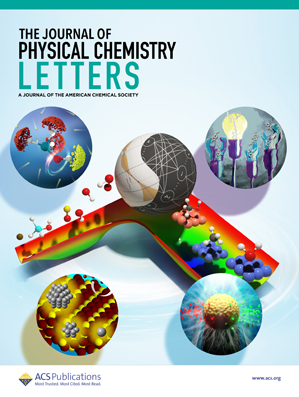氦氖二聚体 4He20Ne 和 4He22Ne 的振荡基态成像
IF 4.8
2区 化学
Q2 CHEMISTRY, PHYSICAL
引用次数: 0
摘要
氦-氖二聚体已经受到了许多理论研究,其中氦-氖系统的相互作用势的计算精度越来越高。计算预测,氦氖系统只支持几个束缚态,这使得标准光谱技术无法达到该系统。以前的实验通过比较测量和预测的散射截面来探测氦氖势。然而,氦氖系统束缚态的空间结构和能量学还没有得到详细的实验研究。利用库仑爆炸成像(CEI)测量了氦氖二聚体4He20Ne和4He22Ne在旋转振动基态下的对距分布。对于每个二聚体,从测量的对距离分布中提取结合能。此外,对距离分布提供了获得氦氖势的途径。本文章由计算机程序翻译,如有差异,请以英文原文为准。

Imaging the Rovibrational Ground State of the Helium–Neon Dimers 4He20Ne and 4He22Ne
The helium–neon dimer has been subject to many theoretical studies, in which the interaction potential of the helium–neon system has been calculated with ever increasing accuracy. Calculations predict that the helium–neon system supports only a few bound states, which makes the system inaccessible to standard spectroscopic techniques. Previous experiments have probed the helium–neon potential by comparing measured and predicted scattering cross sections. However, the spatial structure and energetics of the bound states of the helium–neon system have not been studied experimentally in great detail. We employ Coulomb explosion imaging (CEI) to measure the pair distance distributions of the helium–neon dimers 4He20Ne and 4He22Ne in their rovibrational ground state. For each dimer, the binding energy is extracted from the measured pair distance distribution. Additionally, the pair distance distribution provides access to the helium–neon potential.
求助全文
通过发布文献求助,成功后即可免费获取论文全文。
去求助
来源期刊

The Journal of Physical Chemistry Letters
CHEMISTRY, PHYSICAL-NANOSCIENCE & NANOTECHNOLOGY
CiteScore
9.60
自引率
7.00%
发文量
1519
审稿时长
1.6 months
期刊介绍:
The Journal of Physical Chemistry (JPC) Letters is devoted to reporting new and original experimental and theoretical basic research of interest to physical chemists, biophysical chemists, chemical physicists, physicists, material scientists, and engineers. An important criterion for acceptance is that the paper reports a significant scientific advance and/or physical insight such that rapid publication is essential. Two issues of JPC Letters are published each month.
 求助内容:
求助内容: 应助结果提醒方式:
应助结果提醒方式:


